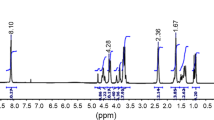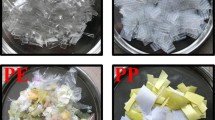Abstract
As a method of recycling, post-consumer waste poly(ethylene terephthalate) (WPET) was upgraded through blending with low ratios (5–10 %) of poly(ethylene glycol) (PEG), poly(methyl methacrylate) (PMMA), hydroxyethyl cellulose (HEC). WPET was also blended with radiation synthesized copolymers based on maleic anhydride (MAN) with methyl methacrylate (MMA), styrene (Sty) and vinyl acetate (VAc) monomers. The thermal stability of the different WPET blends was evaluated by thermogravimetric analysis (TGA) and differential scanning calorimetry (DSC), whereas the dyeability of the different WPET blends was evaluated by dyeing with the classic disperse and basic dyes. The results showed that the blending of WPET with polymers or copolymers ended with modified blends with improved thermal stability and dyeability with basic and disperse dyes compared to non-treated WPET. In this regard, the colour intensity of WPET blended with 10 % of PMMA polymer and MAN/VAc copolymer and dyed with the disperse dye was increased by 74% and 57 %, respectively. For the same blends but dyed with basic dyes, the colour intensity was increased by 483% and 733 %, respectively. Based on the results achieved, it can be concluded that the blending of WPET with pure polymers or copolymers may be considered a practical method of waste PET recycling.










Similar content being viewed by others
References
Awaja F, Pavel D (2005) Recycling of PET. Eur Polym J 41:1453
Fraïsse F, Verney V, Commereuc S, Obadal M (2005) Recycling of poly(ethylene terephthalate)/polycarbonate blends. Polym Degrad Stab 90:250
Friedrich K, Evstatiev M, Fakirov S, Evstatiev O, Ishii M, Harrass M (2005) Microfibrillar reinforced composites from PET/PP blends: processing morphology and mechanical properties. Compos Sci Tech 65:107
Tao Y, Mai K (2007) Non-isothermal crystallization and melting behavior of compatibilized polypropylene/recycled poly(ethylene terephthalate) blends. Eur Polym J 43:3538
Navarro R, Ferrándiz S, López JVJ, Seguí VJ (2008) The influence of polyethylene in the mechanical recycling of polyethylene terephthalate. J Mater Process Technol 195:110
Yi X, Xu L, Wang YL, Zhong GJ, Ji X, Li ZM (2010) Morphology and properties of isotactic polypropylene/poly(ethylene terephthalate) in situ microfibrillar reinforced blends: influence of viscosity ratio. Eur Polym J 46:719
Jayanarayanan K, Thomas S, Kuruvilla JK (2008) Morphology, static and dynamic mechanical properties of in situ microfibrillar composites based on polypropylene/poly (ethylene terephthalate) blends. Compos Part A: Appl Sci Manuf 39:164
Albano C, Camacho N, Hernández M, Matheus A, Gutiérrez A (2009) Influence of content and particle size of waste PET bottles on concrete behavior at different w/c ratios. Waste Manag 29:2707
Lei Y, Wu Q, Zhang Q (2009) Morphology and properties of microfibrillar composites based on recycled poly (ethylene terephthalate) and high density polyethylene. Compos Part A: Appl Sci Manuf 40:904
Santos P, Pezzin SH (2003) Mechanical properties of polypropylene reinforced with recycled-PET fibers. J Mater Process Technol 143–144:517
Nizam El-Din HM, El-Naggar AM (2008) Dyeability of Poly(vinyl butyral) blends with polystyrene and poly(ethylene glycol). Polym Compos 29:597
Nizam El-Din HM, El-Naggar AM, Ali FI (2003) Miscibility of poly(vinyl alcohol)/polyacrylamide blends before and after gamma irradiation. Polymer Int 52:225
Nizam El-Din HM, El-Naggar AM, Ali FI (2006) Thermal decomposition behavior of gamma irradiated poly(vinyl acetate)/poly(methyl methacrylate) miscible blends. J Appl Polymer Sci 99:1773
Whitten KW, Gailey KD (1981) General chemistry with qualitative analysis. Saunders, Philadelphia
Anderson DA, Freeman ES (1961) Thermal kinetics of polymers. J Polymer Sci 54:253
Sperling LH (1986) Introduction to physical polymer science. Wiley Interscience John Wiley & Sons
Fox TG (1956) Bull Am Phys Soc 1:123
Author information
Authors and Affiliations
Corresponding author
Rights and permissions
About this article
Cite this article
El-Naggar, A.W.M., Said, H.M. & Khaffaga, M.R. Influence of blending functional polymers and radiation synthesized copolymers on the recycling of poly(ethylene terephthalate). Int J Plast Technol 16, 1–16 (2012). https://doi.org/10.1007/s12588-012-9025-5
Received:
Accepted:
Published:
Issue Date:
DOI: https://doi.org/10.1007/s12588-012-9025-5




